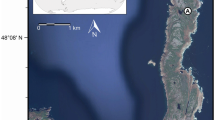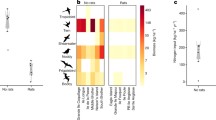Abstract
Seabirds create fluxes of nutrients from marine to terrestrial ecosystems that influence the food webs of small islands. We investigated how guano inputs shape terrestrial food webs by comparing species of selected plant and animal species in a red-footed booby colony in Mona Island (Puerto Rico, Caribbean Sea), to sites of the island lacking guano inputs. We quantified guano deposition and its relationship to plant biomass production, fecundity and density, as well as the activity of native and introduced animal species. In general, guano inputs increased the gross primary plant productivity, size, and fecundity by twofold. Guano inputs were also associated with twofold increases in density of Anole lizards, but also to increases in the activity of introduced pigs (> 500%), goats (> 30%), and cats (> 500%), which negatively impact native species. In particular, elevated pig and cat activity within the booby colony was correlated with lower activity of endemic ground lizards and of introduced rats. Our results also suggest that severe droughts associated with climate change exacerbate the negative effects that introduced species have on vegetation and reduce the positive effects of seabird guano inputs. Our findings underscore the importance of allochthonous guano inputs in subsidizing plant productivity and native and endemic species in small oceanic islands, but also in increasing the negative impacts of introduced mammals. Management and conservation efforts should focus on the exclusion (or eradication) of introduced mammals, particularly pigs and goats, from remnant seabird colonies in Mona Island.





Similar content being viewed by others
Data availability
Data available at https://github.com/BIOL450W/Mona_Island_Data.
References
Anderson WB, Polis GA (1999) Nutrient fluxes from water to land: seabirds affect plant nutrient status on Gulf of California islands. Oecologia 118(3):324–332
Augspurger CK (1980) Mass-flowering of a tropical shrub (Hybanthus prunifolius): influence on pollinator attraction and movement. Evolution 34(3):475–488
Augustine DJ, McNaughton SJ, Frank DA (2003) Feedbacks between soil nutrients and large herbivores in a managed savanna ecosystem. Ecol Appl 13(5):1325–1337
Barnés V Jr (1946) The birds of Mona Island, Puerto Rico. Auk 63(3):318–327
Baum JK, Worm B (2009) Cascading top-down effects of changing oceanic predator abundances. J Anim Ecol 78(4):699–714
Blinn A J, and Carlo T A. (2019). Vegetation and population survey of the red-footed booby (Sula sula L.) colony in Mona Island. Caribbean Naturalist. No. 70
Borroto-Páez R, Woods CA (2012) Status and impact of introduced mammals in the West Indies. Terr. Mamm. West Indies Contrib 241–257
Brusi y Font DJ (1884) Viaje a la Isla de Mona. 2da edición (1997). Instituto de cultura puertorriqueña, San Juan Puerto Rico. Library of Congress Catalog Number: 97---071596
Carlo TA, Aukema JE, Morales JM (2007) Plant-frugivore interactions as spatially explicit networks: integrating animal foraging and fruiting plant spatial patterns. In: Dennis A, Schupp E, Wescott D (eds) Seed dispersal: theory and its application in a changing world. CABI, Oxon, UK, pp 369–390
Coblentz BE (1978) The effects of feral goats (Capra hircus) on island ecosystems. Biol Cons 13(4):279–286
Courchamp F, Chapuis JL, Pascal M (2003) Mammal invaders on islands: impact, control and control impact. Biol Rev 78(3):347–383
Dawson EY (1966) 27. Cacti in the Galápagos Islands, with special reference to their relations with tortoises. In: Bowman RI (ed) The Galápagos: proceedings of the symposia of the Galápagos international scientific project. University of California Press, Berkeley, pp 209–214
Ellis JC (2005) Marine birds on land: a review of plant biomass, species richness, and community composition in seabird colonies. Plant Ecol 181(2):227–241
Espíndola WD, Cruz-Mendoza A, Garrastazú A, Nieves MA, Rivera-Milán F, F., & Carlo, T. A. (2023) Estimating population size of red-footed boobies using distance sampling and drone photography. Wildl Soc Bull 47(1):e1406
Fukami TD, Wardle P, Bellingham C, Mulder D, Towns G, Yeates K, Bonner M, Durrett M-H, Williamson W (2006) Above- and Below-Ground Impacts of Introduced Predators in Seabird-Dominated Island Ecosystems. Ecol Lett 9:1299–1307
Gaiotto JV, Abrahão CR, Dias RA, Bugoni L (2020) Diet of invasive cats, rats and tegu lizards reveals impact over threatened species in a tropical island. Perspectives in Ecol Conser 18(4):294–303
Groom MJ (1998) Allee effects limit population viability of an annual plant. Am Nat 151(6):487–496
Hassan N, Li X, Wang J, Zhu H, Nummi P, Wang D, Zhong Z (2021) Effects of grazing on c: n: p stoichiometry attenuate from soils to plants and insect herbivores in a semi-arid grassland. Oecologia 195:785–795
Henderson RW, Powell R (2009) Natural history of West Indian reptiles and amphibians. University Press of Florida, Gainesville, p 496
Herrera D, Ault T (2017) Insights from a new high-resolution drought atlas for the Caribbean spanning 1950–2016. J Clim 30(19):7801–7825
Holling CS (1959) Some characteristics of simple types of predation and parasitism. Can Entomol 91(7):385–398
Ickes K, Paciorek CJ, Thomas SC (2005) Impacts of nest construction by native pigs (Sus scrofa) on lowland Malaysian rain forest saplings. Ecology 86(6):1540–1547
Kepler CB (1978) The breeding ecology of sea birds on Monito Island. Puerto Rico the Condor 80(1):72–87
Kier G, Kreft H, Lee TM, Jetz W, Ibisch PL, Nowicki C, Mutke J, Barthlott W (2009) A global assessment of endemism and species richness across island and mainland regions. Proc Natl Acad Sci 106(23):9322–9327
Lazaro A, Totland Ø (2010) Local floral composition and the behaviour of pollinators: attraction to and foraging within experimental patches. Ecol Entomol 35(5):652–661
LeBauer DS, Treseder KK (2008) Nitrogen limitation of net primary productivity in terrestrial ecosystems is globally distributed. Ecology 89(2):371–379
Linhares BDA, Ferreira LCL, Bugoni L (2023) The foraging ecology of invasive black rats (Rattus rattus) differs in two nearby islands in a dry tropical archipelago in Brazil. Biol Invasions 25(4):1211–1226
Linhares BDA, Bugoni L (2023) Seabirds subsidize terrestrial food webs and coral reefs in a tropical rat-invaded archipelago. Ecol Appl 33(2):e2733
Markwell TJ, Daugherty CH (2002) Invertebrate and lizard abundance is greater on seabird-inhabited islands than on seabird-free islands in the Marlborough Sounds. N Z Ecoscience 9(3):293–299
Martin JL, Thibault JC, Bretagnolle V (2000) Black rats, island characteristics, and colonial nesting birds in the Mediterranean: consequences of an ancient introduction. Conserv Biol 14(5):1452–1466
Martinuzzi S, Gould WA, Ramos Gonzalez OM, Martinez Robles A, Calle Maldonado P, Pérez-Buitrago N, Fumero Caban JJ (2008) Mapping tropical dry forest habitats integrating Landsat NDVI, Ikonos imagery, and topographic information in the Caribbean Island of Mona. Rev Biol Trop 56(2):625–639
Meléndez-Ackerman EJ, Cortés C, Sustache J, Aragón S, Morales-Vargas M, García-Bermúdez M, Fernández DS (2008) Diet of feral goats in Mona Island reserve. Puerto Rico Caribbean J Sci 44(2):199–205
Morales JM, Rivarola MD, Amico G, Carlo TA (2012) Neighborhood effects on seed dispersal by frugivores: testing theory with a mistletoe–marsupial system in Patagonia. Ecology 93(4):741–748
Nogales M, Vidal E, Medina FM, Bonnaud E, Tershy BR, Campbell KJ, Zavaleta ES (2013) Feral cats and biodiversity conservation: the urgent prioritization of island management. Bioscience 63(10):804–810
Nogueira-Filho SL, Nogueira SS, Fragoso JM (2009) Ecological impacts of feral pigs in the Hawaiian Islands. Biodivers Conserv 18(14):3677
Obeso JR (2002) The costs of reproduction in plants. N Phytol 155(3):321–348
Paleczny M, Hammill E, Karpouzi V, Pauly D (2015) Population trend of the world’s monitored seabirds, 1950–2010. PLoS ONE 10(6):e0129342
Parsons MH, Banks PB, Deutsch MA, Munshi-South J (2018) Temporal and space-use changes by rats in response to predation by feral cats in an urban ecosystem. Front Ecol Evol 6:146
Polis GA, Hurd SD (1995) Extraordinarily high spider densities on islands: flow of energy from the marine to terrestrial food webs and the absence of predation. Proc Natl Acad Sci 92(10):4382–4386
Polis GA, Hurd SD (1996a) Linking marine and terrestrial food webs: allochthonous input from the ocean supports high secondary productivity on small islands and coastal land communities. Am Nat 147(3):396–423
Polis GA, Hurd SD (1996b) Allochthonous input across habitats, subsidized consumers, and apparent trophic cascades: examples from the ocean-land interface. Springer, Boston, MA, In Food Webs. https://doi.org/10.1007/978-1-4615-7007-3_27
Raffaele H (1973) Assessment of Mona island avifauna. Monito and Mona Islands: An assessment of their natural and historical resources. San Juan: Puerto Rico Environ Qual Board 2:K1–K32
Richardson KM, Iverson JB, Kurle CM (2019) Marine subsidies likely cause gigantism of iguanas in the Bahamas. Oecologia 189(4):1005–1015
Rojas-Sandoval J, Meléndez-Ackerman EJ (2009) Pollination biology of Harrisia portoricensis (Cactaceae), an endangered Caribbean species. Am J Bot 96(12):2270–2278
Rojas-Sandoval J, Meléndez-Ackerman EJ (2013) Spatial patterns of distribution and abundance of Harrisia portoricensis, an endangered Caribbean cactus. J Plant Ecol 6(6):489–498
Samson AV, Cooper J (2015) History on Mona Island: long-term human and landscape dynamics of an ‘uninhabited’island. New West Indian Guide/nieuwe West-Indische Gids 89(1–2):30–60
Sanchez G (2013) PLS path modeling with R. Berkeley Trowchez Editions. 383(2013):551
Sánchez-Piñero F, Polis GA (2000) Bottom-up dynamics of allochthonous input: direct and indirect effects of seabirds on islands. Ecology 81(11):3117–3132
Towns DR (2018) Understanding seabird responses to invasive mammal eradications from islands needs systematic monitoring. Anim Conserv 21(1):15–16
Vitousek PM, Porder S, Houlton BZ, Chadwick OA (2010) Terrestrial phosphorus limitation: mechanisms, implications, and nitrogen–phosphorus interactions. Ecol Appl 20(1):5–15
Wait DA, Aubrey DP, Anderson WB (2005) Seabird guano influences on desert islands: soil chemistry and herbaceous species richness and productivity. J Arid Environ 60(4):681–695
Zegarra-Vila JP, García-Bermúdez MA, Figuerola-Hernández CE, Llerandi-Román I, Angeli N, López-Ortiz R, Monsegur-Rivera OA (2022) The Road to Recovery of the Monito Gecko (Sphaerodactylus micropithecus). Caribbean Naturalist 87:1–15
Acknowledgements
We thank Miguel (Tony) Nieves who encouraged and helped us to conduct this research in Mona. For help in conducting fieldwork, we thank Cameron P. Venable, Aralcy Garrastazú, Alex Curtze, and Alberto C. Cruz-Mendoza. Samantha Allbee, J.V.S Messeder, A. Cruz-Mendoza, and J.I. Irizarry commented on earlier versions of the manuscript.
Funding
The project was funded by the Biology Department of Penn State University, and by the Puerto Rico Department of Natural and Environmental Resources (DRNA).
Author information
Authors and Affiliations
Contributions
WDE and TAC conceived the study, analyzed the data, and wrote the manuscript.
Corresponding author
Ethics declarations
Conflict of interest
The corresponding author confirms on behalf of all authors that there have been no involvements that might raise the question of bias in the work reported or in the conclusions, implications, or opinions stated.
Additional information
Communicated by Amy Austin.
Supplementary Information
Below is the link to the electronic supplementary material.
Rights and permissions
Springer Nature or its licensor (e.g. a society or other partner) holds exclusive rights to this article under a publishing agreement with the author(s) or other rightsholder(s); author self-archiving of the accepted manuscript version of this article is solely governed by the terms of such publishing agreement and applicable law.
About this article
Cite this article
Espíndola, W.D., Carlo, T.A. Seabird guano inputs increase impacts from introduced mammals on the native plants and animals of an oceanic island. Oecologia (2024). https://doi.org/10.1007/s00442-024-05546-7
Received:
Accepted:
Published:
DOI: https://doi.org/10.1007/s00442-024-05546-7




